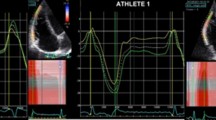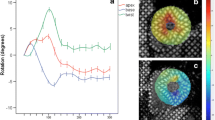Abstract
The effects of a short, high-intensity bout of exercise on cardiac systolic and diastolic function are not well understood in adolescent athletes. Consequently, the aims of the study were to evaluate global left ventricular (LV) systolic and diastolic function, as well as segmental wall motion responses (cardiac strain), prior to as well as 45 and 225 min following a simulated 5 km cross-country race. Twenty trained, adolescent males (age: 15.2 ± 0.7 years) volunteered for exercise testing. LV fractional shortening and the ratio of early (E) and late (A) peak flow velocities reflected global systolic and diastolic function, respectively. Peak longitudinal mitral annular septal tissue velocities were also determined during systole and diastole. Longitudinal strain (ε) and strain rates were determined across the LV. LV fractional shortening was significantly (P < 0.05) higher at 225 min post-race (37.6 ± 5.8 %) compared to pre-race (34.5 ± 4.7 %) and 45 min post-race (34.9 ± 5.4 %). This difference was abolished after adjusting for post-race heart rates. There was a significant (P < 0.05) decrease in the E:A ratio at both 45 min (2.04 ± 0.57) and 225 min post-race (2.20 ± 0.66) compared to the pre-race value (2.80 ± 0.68). When these data were adjusted for post-race heart rates, these pre-post-race differences in E:A ratio were abolished. There were no significant alterations in either tissue Doppler velocities or longitudinal ε. The evidence suggests that a 5 km race does not lead to any significant post-exercise attenuation in global or regional LV systolic and diastolic function in trained adolescents.





Similar content being viewed by others
References
Burns AT, Connelly KA, La Gerche A et al (2007) Effect of heart rate on tissue Doppler measures of diastolic function. Echocardiography 24:697–701. doi:10.1111/j.1540-8175.2007.00466.x
Dawson EA, Whyte GP, Black MA et al (2008) Changes in vascular and cardiac function after prolonged strenuous exercise in humans. J Appl Physiol 105:1562–1568. doi:10.1152/japplphysiol.90837.2008
George K, Oxborough D, Forster J et al (2005) Mitral annular myocardial velocity assessment of segmental left ventricular diastolic function after prolonged exercise in humans. J Physiol 569:305–313. doi:10.1113/jphysiol.2005.095588
George K, Shave R, Oxborough D et al (2009) Left ventricular wall segment motion after ultra-endurance exercise in humans assessed by myocardial speckle tracking. Eur J Echoacardior 10:238–243. doi:10.1093/ejechocard/jen207
Hauser M, Petzuch K, Kuhn A et al (2013) The Munich triathlon heart study: ventricular function, myocardial velocities, and two-dimensional strain in healthy children before and after endurance stress. Pediatr Cardiol 34:576–582. doi:10.1007/s00246-012-0500-8
Lang RM, Bierig M, Devereux RB et al (2005) Recommendations for chamber quantification: a report from the American Society of Echocardiography’s Guidelines and Standards Committee and the Chamber Quantification Writing Group, developed in conjunction with the European Association of Echocardiography, a branch of the European Society of Cardiology. J Am Soc Echocardiogr 18:1440–1463. doi:10.1016/j.echo.2005.10.005
Matsudo SMM, Matsudo VKR (1994) Self-assessment and physician assessment of sexual maturation in Brazilian boys and girls: Concordance and reproducibility. Am J Human Biol 6:451–455. doi:10.1002/ajhb.1310060406
Middleton N, Shave R, George K et al (2006) Left ventricular function immediately following prolonged exercise: a meta analysis. Med Sci Sports Exerc 38:681–687. doi:10.1249/01.mss.0000210203.10200.12
Middleton N, Shave R, George K et al (2007) Impact of repeated prolonged exercise bouts on cardiac function and biomarkers. Med Sci Sports Exerc 39:83–90. doi:10.1249/01.mss.000023935.93578.60
Neilan TG, Yoerger DM, Douglas PS et al (2006) Persistent and reversible cardiac dysfunction among amateur marathon runners. Eur Heart J 27:1079–1084. doi:10.1093/eurheartj/ehi813
Neilan TG, Januzzi JL, Lee-Lewandrowski E et al (2006) Myocardial injury and ventricular dysfunction related to training levels among nonelite participants in the Boston Marathon. Circulation 114:2325–2333. doi:10.1161/CIRCULATIONAHA.106.647461
Nie J, George KP, Tong TK et al (2011) Effect of repeated endurance runs on cardiac biomarkers and function in adolescents. Med Sci Sports Exerc 43:2081–2088. doi:10.1249/mss.0b013e31821d4a82
Oxborough D, Birch K, Shave R et al (2010) “Exercise-induced cardiac fatigue”—a review of the echocardiographic literature. Echocardiography 27:1130–1140. doi:10.1111/j.1540-8175.2010.01251.x
Oxborough DM, Shave RP, Warburton DP et al (2011) Dilatation and dysfunction of the right ventricle immediately after ultraendurance exercise: exploratory insights from conventional two-dimensional and speckle tracking echocardiography. Circ Cardiovasc Imaging 4:253–263. doi:10.1161/CIRCIMAGING.110.961938
Rowland T, Goff D, DeLuca P et al (1997) Cardiac effects of a competitive road race in trained child runners. Pediatrics 100:E2. doi:10.1542/peds.100.3.e2
Rowland TW, Garrard M, Marwood S et al (2009) Myocardial performance during progressive exercise in athletic adolescent males. Med Sci Sports Exerc 41:1721–1728. doi:10.1249/MSS.0b013e3181a06cb5
Scott JM, Warburton DER (2008) Mechanisms underpinning exercise-induced changes in left ventricular function. Med Sci Sports Exerc 40:1400–1407. doi:10.1249/MSS.0b013e318172cf10
Shave R, Oxborough D (2012) Exercise-induced cardiac injury: evidence from novel imaging techniques and highly sensitive cardiac troponin assays. Prog Cardiovasc Dis 54:407–415. doi:10.1016/j.pcad.2012.01.007
Shave R, George K, Whyte G et al (2008) Post exercise changes in left ventricular function: the evidence so far. Med Sci Sports Exerc 40:1393–1399. doi:10.1249/MSS.0b013e318172cf36
Wilson M, O’Hanlon R, Prasad S et al (2011) Biological markers of cardiac damage are not related to measures of cardiac systolic and diastolic function using cardiovascular magnetic resonance and echocardiography after an acute bout of prolonged exercise. Br J Sports Med 45:780–784. doi:10.1136/bjsm.2009.064089
Acknowledgments
Thanks to Kirsty Woodward, Aaron Sharpes and Thomas Hulme for their help with the organization of the 5 km race and the associated data collection.
Author information
Authors and Affiliations
Corresponding author
Rights and permissions
About this article
Cite this article
Unnithan, V.B., Rowland, T., George, K. et al. Regional and Global Left Ventricular Function Following a Simulated 5 km Race in Sports-Trained Adolescents. Pediatr Cardiol 36, 322–328 (2015). https://doi.org/10.1007/s00246-014-1006-3
Received:
Accepted:
Published:
Issue Date:
DOI: https://doi.org/10.1007/s00246-014-1006-3




